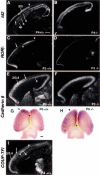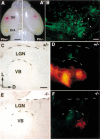COUP-TFI: an intrinsic factor for early regionalization of the neocortex
- PMID: 11511537
- PMCID: PMC312763
- DOI: 10.1101/gad.913601
COUP-TFI: an intrinsic factor for early regionalization of the neocortex
Abstract
Regionalization of the cerebral cortex is thought to involve two phases: an early regionalization phase and a later refinement phase. It has been shown that early regionalization of the neocortex does not require thalamic inputs and is regulated by intrinsic factors. Recently, two such intrinsic factors, Pax6 and Emx2, have been identified. In this study, we identified COUP-TFI as a regulatory factor for early neocortical regionalization. The spatial and temporal expression pattern of COUP-TFI suggested a role in specification of the neocortex and in maintaining cortical identity. Altered region-specific expression of marker genes in the cortex as well as miswired area-specific connections between the cortex and the thalamus in COUP-TFI null mice indicate COUP-TFI plays a critical role in regulating early regionalization. Our results substantiate that COUP-TFI, an intrinsic factor, may work in concert with Pax6 and Emx2 to specify neocortical identity.
Figures





References
-
- Bishop KM, Goudreau G, O’Leary DD. Regulation of area identity in the mammalian neocortex by Emx2 and Pax6. Science. 2000;288:344–349. - PubMed
-
- Bulfone A, Smiga SM, Shimamura K, Peterson A, Puelles L, Rubenstein JL. T-brain-1: A homolog of Brachyury whose expression defines molecularly distinct domains within the cerebral cortex. Neuron. 1995;15:63–78. - PubMed
-
- Caviness VS, Takahashi T, Nowakowski RS. Numbers, time and neocortical neuronogenesis: A general developmental and evolutionary model. Trends Neurosci. 1995;18:379–383. - PubMed
-
- Gulisano M, Broccoli V, Pardini C, Boncinelli E. Emx1 and Emx2 show different patterns of expression during proliferation and differentiation of the developing cerebral cortex in the mouse. Eur J Neurosci. 1996;8:1037–1050. - PubMed
Publication types
MeSH terms
Substances
LinkOut - more resources
Full Text Sources
Other Literature Sources
Molecular Biology Databases
